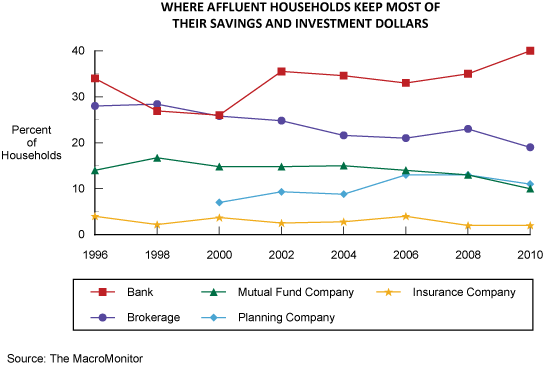MacroMonitor Market Trends February 2012
MacroMonitor Market Trends is a newsletter from Consumer Financial Decisions that highlights topical news and trends of interest to you and your colleagues. If you would like more information about the topic in the newsletter or would like to discuss other ways that we can assist you in your research and marketing efforts, please contact us.
In Trying Times, Consumers Vote with Their Dollars
MacroMonitor data show how the market shares of consumer savings and investments change with the financial markets and the economy; the picture is one with potentially lasting implications. The figure shows trended data for years that include two major bubbles and bursts that shape today's consumers' financial attitudes and actions.
Trended data are for Affluent Core Customer segments. Affluent households are households with $100K or more in income OR $500K in total assets excluding the home. To determine their institutional orientation, CFD segments affluent households on the basis of where they hold the greatest proportion of their savings and investments.

Since 1998, when the combined full-service/discount-brokerage category and mutual fund companies enjoyed their highest shares of consumer-dollar votes, the share of institution orientations has changed dramatically: The group of bank-oriented households has increased by nearly half (up 49%), the brokerage-oriented group has declined 39%, and the group of households with a mutual fund–company orientation has contracted by 40%. From the point at which we added the financial-planning-company orientation to the mix in 2000, that group has seen its opportunity grow by more than 57%. Generally speaking, consumers commit a solid majority of their investable assets to their chosen type of institution. On average, the proportion of investable assets held by households with the various orientations is bank, 77%; brokerage, 73%; mutual fund company, 70%; financial-planning company, 71%; insurance company, 61%.
With customer retention will come the opportunity for growth. Thus, for example, the aggregate effects of economic and financial events on households' trust, confidence, expectations, and risk appetite. How these factors influence consumers' perceptions of institution-based orientations—of your institution's orientation, in particular—will determine your organization's prospects.
CFD is dedicated to helping you compete through a comprehensive understanding of US households' needs, behaviors, and attitudes. For more information, contact CFD.